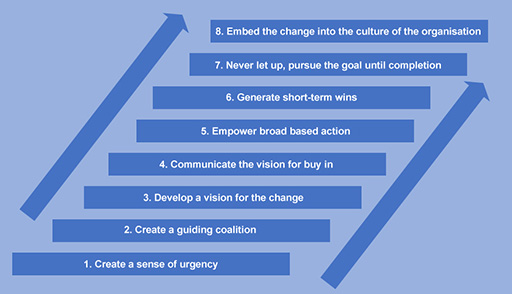4.2 Being a strategic leader and change manager
Strategic leadership whilst not a model of leadership per se is a key dimension of any leadership activity and there has been a great deal written about what strategic leaders do, and the characteristics that strategic leaders display (Davies and Davies, 2006). Davies and Davies, (2006) writing in 2006 described five key activities of strategic leaders:
- Direction setters -setting
- Translating strategy into action
- Enabling staff to develop and deliver the strategy
- Determining effective intervention points
- Developing strategic capabilities
These 5 activities mirror many models of change management and align well with John Kotter’s 8 step change model, (Figure 5), which has been very influential in the field since it was published in 1995 (Kotter, 1995, 1996).
- The first priority according to the model, is to create a sense of urgency; on the basis that nothing will be implemented unless there is a need for it. This was very evident during lockdowns, when schools had to implement a digital strategy almost overnight.
- Create a guiding coalition – it is important to create support for your strategy, both material and cultural. Any change project includes a substantial element of culture change, and this can be very difficult and time consuming to achieve. Analysing your stakeholders and ascertaining which will be ‘blockers’ and which ‘facilitators’ of your change, is an important element within any change management project.
- Develop a vision for the change – if you don’t have a vision of what you would like to happen, it is unlikely that it ever will. You will also fail to convince others of the ‘big picture.’ Your vision may be a blended learning environment, or a fully digital school, either way it is important you are able to set this out from the outset.
- Communicate the vision for buy in – As important as the vision is, without an effective communication strategy it is likely to fail.
- Empower broad based action – Pockets of innovation are good but in order for a vision to succeed you will need to enable action across the whole school.
- Generate short term wins – Pockets of good practice can be used to generate interest, small scale low risk ‘pilot projects’ can do a great deal to get staff onside. Particularly if those staff evaluate them and adapt them for ‘business as usual.’
- Never let up – change is difficult, it will take some time to achieve your goals, but persistence and resilience in the face of obstacles go a long way.
- Embed the change into the culture of the organisation. This is a key element to achieving any strategic change. Embedding change into projects prepares the school/s for the transition from “how we do things now” to “how we will do things in the future.” Engaging people in the process of change is critical to ensuring a successful outcome
However, Kotter’s model is not without its critics. O’Keefe and O’Riordan (2011), identify 2 primary flaws of Kotter’s model:
- The model positions change as a one-off event with a defined beginning and a successful end, reached via the 8 steps. O'Keefe makes the very valid point that in the current environment of global uncertainty continuous change is now the order of the day.
- Excludes the informal leaders and distributed models of leadership- O’Keefe challenges Kotter's view that significant change can only come from organisational leaders and says that employees become disillusioned if the change only happens from the top. (O'Keefe and O'Riordan, 2011).
Much of the literature on change prompted by crisis discusses the opportunities that inadvertently arise during a crisis, which can actually advance changes which would otherwise have taken years (Maitlis and Sonenshein, 2010). Crisis can also act as key learning events for leaders, particularly in relation to strategy and vision (Weick, 1988; Thürmer et al., 2020).
Listen again to Audio 1 with headteacher Ms Nichols Mackay. This time, consider which elements of Figure 5 were enacted during lockdown, which may have furthered the strategy in the longer term even though it was officially paused during this period.
Transcript: Audio 1 (repeated)
- Lockdown created a sense of urgency for the school to ensure that pupils continued learning throughout the pandemic. This meant that the head and staff discovered the true extent of the lack of both hardware and connectivity of pupils and their families.
- The school’s vision that every pupil should be able to access digital learning, was furthered due to the measures that were put in place during lockdown. If lockdown had not occurred, the development of the strategy would have stalled due to lack of essential devices and bandwidth. Although this issue is not fully resolved, the crisis meant that it was recognised and acted upon much earlier than it would have been otherwise.
- Highlighting the digital divide to governors and other stakeholders, will be key to moving forward with the strategy in future.

